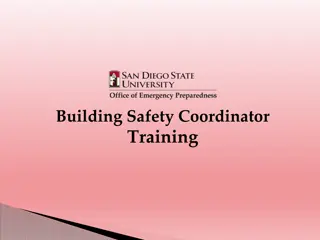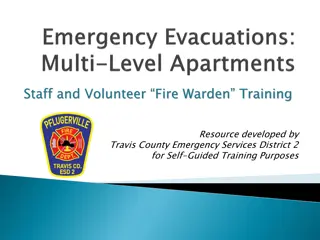Fire Extinguisher Training for Mobile Food Truck Safety
This training module covers essential aspects of fire extinguisher training for mobile food trucks, including the objectives, purpose, emergency action plans, and definitions related to fire safety. It emphasizes the importance of proper training, maintenance, and use of fire extinguishers to control small fires effectively and ensure the safety of employees and customers.
Download Presentation

Please find below an Image/Link to download the presentation.
The content on the website is provided AS IS for your information and personal use only. It may not be sold, licensed, or shared on other websites without obtaining consent from the author. Download presentation by click this link. If you encounter any issues during the download, it is possible that the publisher has removed the file from their server.
E N D
Presentation Transcript
Mobile Food Truck Safety Training Part 5: Fire Extinguisher Training This material was produced under grant number SH-39170-SH2 from the Occupational Safety and Health Administration, U.S. Department of Labor. It does not necessarily reflect the views or policies of the U.S. Department of Labor, nor does mention of trade names, commercial products, or organizations imply endorsement by the U.S. Government.
Objectives After this module, the trainee will be able to: Review the EAP Decision whether employees will fight fires or evacuate Identify the three requirements for a fire to continue Classify types of fires by their characteristics Identify the types of fire extinguishers needed for their business Operate a fire extinguisher Identify conditions when NOT to fight a fire
Purpose of a Fire Extinguisher Two functions: 1. To control or extinguish small or incipient stage fires and, 2. To protect evacuation routes that a fire may block directly or indirectly with smoke or burning materials. Fire extinguishers are designed to put out or control small fires If not controlled immediately, small fires can spread out of control Facilities need the proper types and placement of fire extinguishers as part of a fire protection plan
Review: Emergency Action Plans (EAP) Decision: Should employees evacuate or be prepared to fight small fires? This module will address Fire Extinguisher Training for those authorized to use them Option 1 Option 2 Option 3 Who uses fire extinguishers? Nobody Only designated workers can use All employees are authorized to use Who evacuates? Everyone All others not authorized Anyone not authorized EAP, Fire Prevention, and Training Required? Yes Yes Yes Worker Fire Extinguisher Training Required? No Each authorized employee must be trained annually All authorized employees must be trained annually Additional Requirements Fire Extinguishers must be inspected, tested, and maintained.
Definitions OSHA NFPA "Incipient stage fire means a fire in the initial or beginning stage and can be controlled or extinguished by portable fire extinguishers, Class II standpipe, or small hose systems without the need for protective clothing or breathing apparatus. Incipient stage fire A fire is beyond the incipient stage when the use of thermal protective clothing or self-contained breathing apparatus is required...
Fire Triangle: Fire Needs 3 Elements Fire requires 3 Elements: Take one away fire cannot survive 1. Fuel: Without fuel, a fire will stop. 2. Oxygen: Without sufficient oxygen, a fire can t begin, and it can t continue. 3. Heat: Without sufficient heat, a fire can t begin, and it can t continue. Our strategy in Fire Extinguisher use: Remove one or more of the elements before a fire can spread out of control.
Five Fire Categories What s Present in Your Operation? Yes No Fire Class Materials Class A Fires Combustible materials (wood, cloth, paper, rubber and many plastics) Class B Fires Flammable Liquids (gasoline, kerosene, propane, alcohols) Class C Fires Electrical equipment Class D Fires Metals (magnesium, sodium, lithium) Class K Fires (Kitchen) Grease/Cooking Oils How likely for each to be present in most Food Trucks?
Types of Fire Extinguishers Fire extinguishers must be matched to the hazards present Types: Class A- Wood, Paper, Plastics (Water) Class AB- Wood, Paper, and Flammables (CO2) Class BC- Flammables + Electrical (CO2) Class ABC- Multipurpose (Chemical Powder) Class K- Kitchen Fires (Wet Chemical) Class D- Metal Fires A B C K D Simplify?
Fire Extinguisher Types Fire extinguishers must be matched to the hazards present Types: Class A- Wood, Paper, Plastics (Water) Class AB- Wood, Paper, and Flammables Class BC- Flammables + Electrical (CO2) Class ABC- Multipurpose (Chemical Powder) Class K- Kitchen Fires (Wet Chemical) Class D- Metal Fires A B C K
Class ABC Extinguisher A B C Multipurpose Wood, paper Flammable Liquid Electrical Contains Dry Chemical Fire retardant powder separates the fuel from oxygen Pressure Gauge Verifies Fill Level Note: Mildly Corrosive (Electronic Equipment)
Class K Extinguisher Class K= Kitchen Cooking Oils/Fats Required for all solid fuel cooking with a fire box volume of 5 cubic feet or more (Regardless of whether hood present) Mixture of dry and wet chemicals Electrically conductive Electrical power to the appliance must be shut off first Pressure Gauge Verifies Fill Level Fires burn at very high temperature Agent cools and separates fuel/oxygen K
Location and Placement Must be readily accessible and visible if fire occurs Near kitchen locations, no more than 30 ft away Bottom must be at least 4 inches off the floor Fire extinguisher weighing < 40lb (Lighter) Top cannot be more than 5 ft from floor Fire extinguisher weighing > 40lb (heavier) Top cannot be more than 3.5 ft from floor
Procedures to Respond to a Fire If nobody is authorized to use a fire extinguisher, everyone must evacuate If someone is authorized and trained to use a fire extinguisher: 1) Sound an alarm, call the fire department 2) Identify a safe evacuation path before approaching a fire. Do not allow the fire, heat, or smoke to come between you and evacuation path 3) Select the appropriate fire extinguisher To use Class K Extinguisher, electricity must be off to that appliance 4) Discharge the extinguisher using the P.A.S.S. technique 5) Back away from an extinguished fire if it reignites **Evacuate immediately if the extinguisher is empty and fire is not out **Evacuate immediately if the fire progresses beyond the incipient stage
Is it safe to fight a fire? Criteria Safe NOT Safe Fire has not spread Flames not higher than head Fire has spread beyond origin Flames reaching the ceiling Size of Fire Smoke present, but clear view of the fire No respiratory protection needed Clear exit path behind you Smoke blocking view of fire Air is difficult to breathe Respiratory protection needed Exit path behind you is not safe Fire is not contained, spreading Air Conditions Exit Path If you have the slightest doubt about your ability to fight a fire or the conditions present, EVACUATE IMMEDIATELY!
Use P.A.S.S. P.A.S.S. for Small Fires Pull Pull the pin. Aim Aim extinguisher nozzle or hose at the base of the fire. Squeeze Squeeze handle to release the extinguishing agent. Sweep Sweep sideways at the base of the fire until it is out. Watch the area. If the fire re-ignites, repeat the above.
Inspection, Maintenance, and Testing The employer is responsible for the inspection, maintenance, and testing of portable fire extinguishers in the workplace Monthly inspections Annual Inspections
Monthly Inspections Check/Date Description Is the Fire Extinguisher in its designated place? No obstruction to access or visibility? Is the pressure gauge showing that the extinguisher is fully charged (the needle should be in the green zone)? Is the pin and tamper seal intact? Is the extinguisher in good condition and showing no signs of physical damage, corrosion, or leakage? *Tag on Extinguisher or Paper/Electronic Files are both acceptable *Need: Month/year of inspection and person conducting inspection
Annual Inspections Annually: Use a 3rd party for annual maintenance checks -Annual fire department inspections Hydrostatic Testing: This is a pressure-testing technique used to test for strength and leaks in pressure vessels like gas cylinders. Must be performed by someone with suitable equipment/facilities. Performed every 5-12 years, depends on extinguisher Ensure backup protection when fire extinguishers are removed for maintenance or recharging
Training on Fire Extinguisher Use Authorized Workers must be trained on how to use a fire extinguisher This training does not have to be performed on live fires. Our training will begin in a few minutes
To Summarize: EAPs must describe whether workers will use fire extinguishers for fires Fire extinguishers are only to be used on small (incipient) fires and when a clear exit path is present. The type(s) of fire extinguishers needed depends on the materials present. For most food trucks, a Class ABC (dry powder) extinguisher will be needed, and possibly a Class K extinguisher if cooking oils are present. The P.A.S.S. method should be used to extinguish small fires. Employees must be trained on how to use fire extinguishers.























